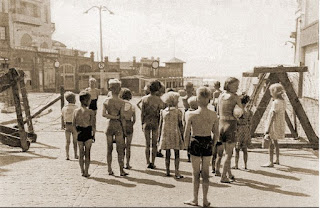Zandvoort, on the edge of the North Sea, is mostly a summer resort town for Germans.
Although we are deep into the winter season, many houses sport te huur signs in their windows, signaling rental possibilities for intrepid off-season travelers.
It's a cute little town with a train station emptying out into the shopping district. I think I will bring Hope back again when the wind dies down.
The town is surrounded by sand dunes, some of which were retained by city planners as a buffer between the down town area and the sea.

The sand dunes are fenced off, but there is a bike path that leads all the way into Haarlem, about seven miles away.
Deer roam freely inside the sand dunes, their population unchallenged by predators.
Engineers have constructed deer overpasses, a couple of which we drove through on our journey, protecting animals from vehicle traffic.
In 1942, the Nazis laid land mines and strung wire in front of the beach, prohibiting Dutch children from playing. A brave photographer captured the scene when the children were told they could no longer go down to the beach.
The Nazis also rounded up Dutch men, and one woman, who were suspected of working for the Resistance. We will probably never know the exact number of people who were marched into the dunes and then shot at close range. Later, after the war, over 400 the bodies were exhumed and a memorial cemetery called Eerebegraafplaats was constructed.
It's ironic to me that so many Germans come to this town for holiday now, and it makes me wonder how many of them navigate their way to this memorial park during their summer vacations.
 |
| original Dutch Resistance poster |







No comments:
Post a Comment